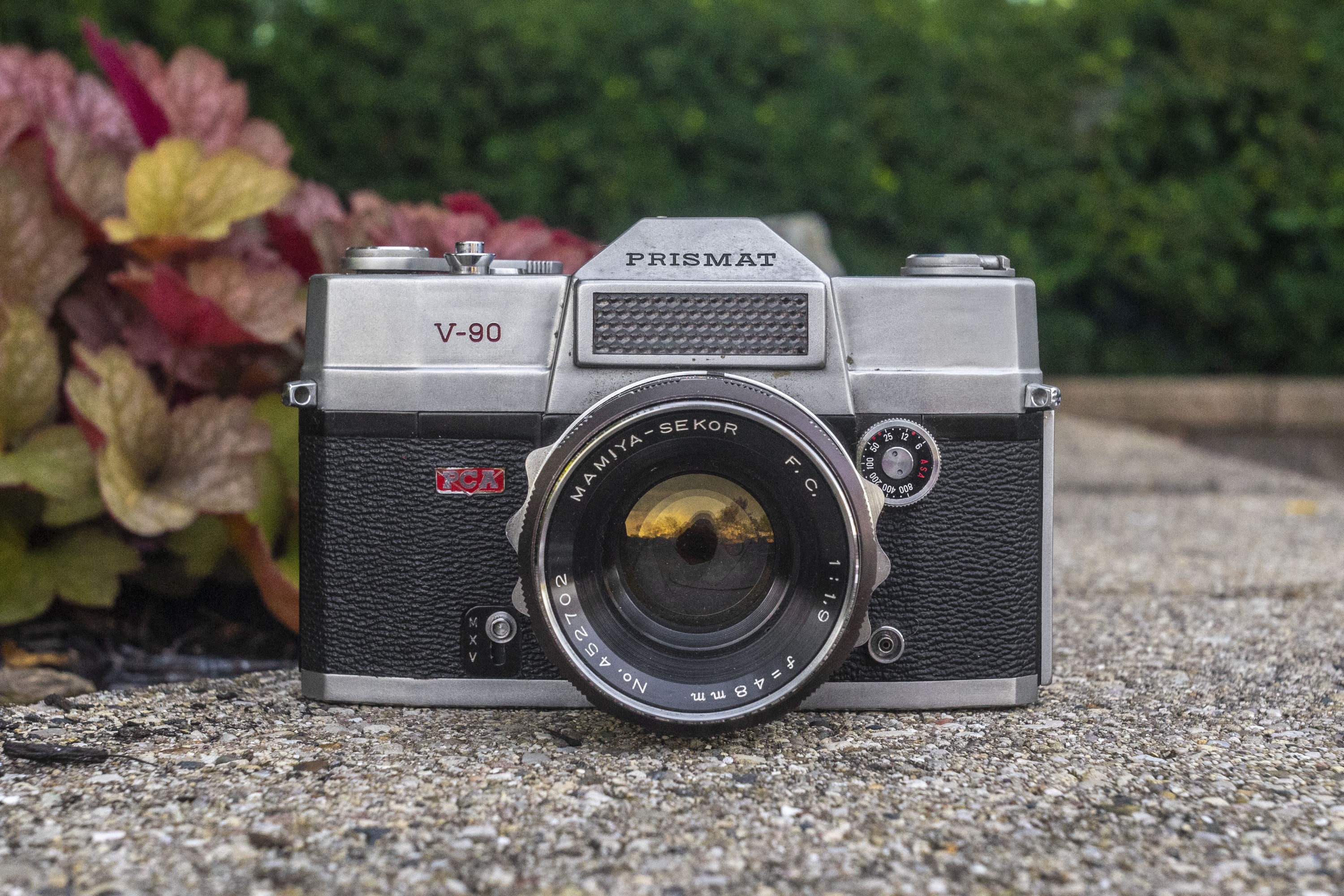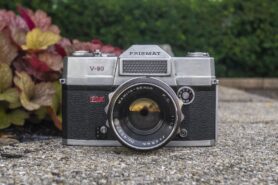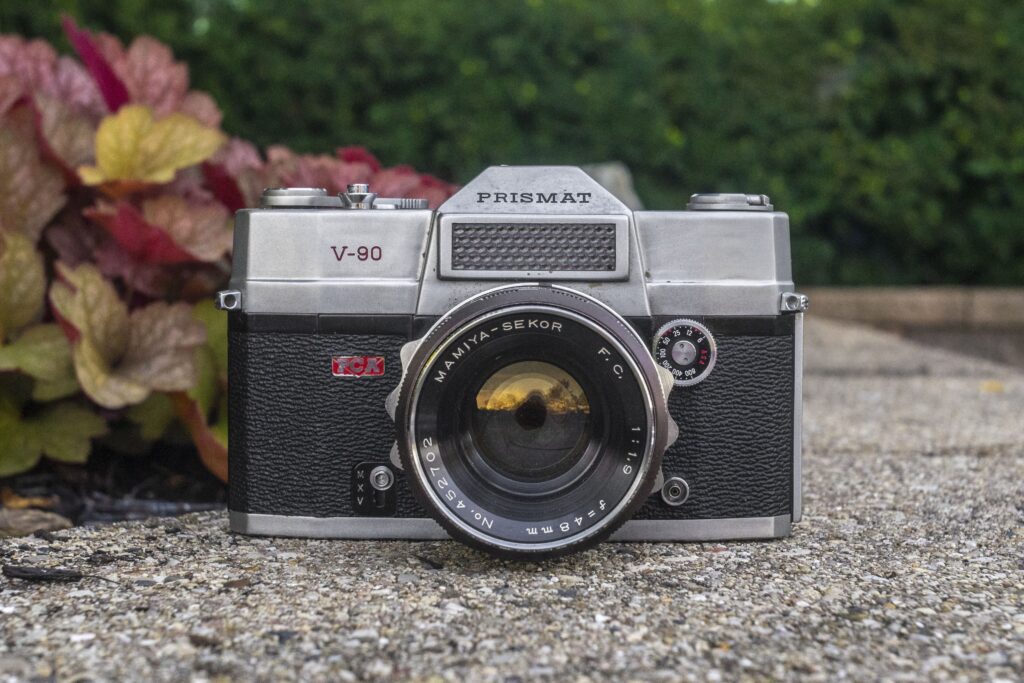This is a PCA Prismat V-90, a 35mm SLR made by Mamiya Camera Co. Ltd. for the Photronic Corporation of America of Takoma Park, MD starting in 1961. The PCA Prismat V-90 is a rebadge of the Mamiya Prismat PH, which itself was part of Mamiya’s robust Prismat SLR family. Unlike other cameras in the Prismat family with focal plane shutters, both the PH and PCA models have a behind the lens Seikosha SLV leaf shutter. To accommodate the leaf shutter, these cameras have a unique bayonet lens mount not shared by any other camera. Like other Mamiya Prismat models, the PCA Prismat V-90 was well constructed and had the support of excellent Mamiya-Sekor lenses.
Film Type: 135 (35mm)
Lens: 48mm f/1.9 Mamiya-Sekor F.C. coated 6-elements in 4-groups
Lens Mount: Prismat PH Mount
Focus: 1.75 feet / 0.5 meters to Infinity
Viewfinder: Fixed SLR Pentaprism, 95% Field of View, 0.8x Magnification
Shutter: Seikosha SLV Leaf
Speeds: B, 1 – 1/500 seconds
Exposure Meter: Coupled Selenium Cell w/ viewfinder match needle
Battery: None
Flash Mount: Hot shoe and M and X Flash Sync
Weight: 960 grams, 745 grams (body only)
Manual: https://www.cameramanuals.org/mamiya_pdf/mamiya_pca_prismat_v-90.pdf
Mamiya’s roots as an SLR maker date back to a prototype camera from 1952 called the Prismflex. As the name suggests, the Prismflex featured a pentaprism viewfinder on top of the camera which for the time was a technology only used by a handful of camera makers. The Prismflex was a compact and attractive camera which had it been put into production would have been the first Japanese pentaprism SLR, beating anyone else to the market by a couple of years.
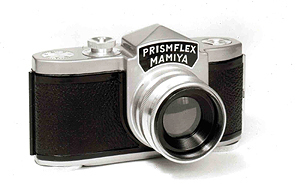
For reasons I’ve never been able to determine, the Prismflex was never released, and would eventually evolve into a very similar camera called the Pentaflex in 1955. The Pentaflex shared many of the same cosmetics of the Prismflex, but appeared to be a more complete model. Based on photo evidence, the Prismflex was likely a non-working mockup, or perhaps even a model of a camera. The Pentaflex looked like a complete camera, but once again, for reasons I’ve never been able to determine, the Pentaflex was never put into production.
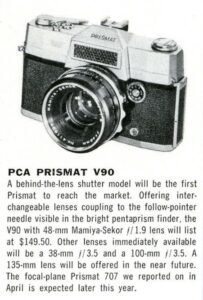
Unlike the three years between the Prismflex and Pentaflex, it appears as though Mamiya’s progress on what would become their first SLR stopped. The world wouldn’t learn of the company’s eventual first SLR until 1960 at the St. Louis Photo Dealers Trade Show when a camera called the PCA Prismat V-90 was revealed. In the June 1960 issue of Popular Photography, a list of cameras shown at the trade show included the short blurb about the PCA Prismat V-90 to the right. The paragraph below suggested the camera would be the first Prismat to reach the market, which although close, didn’t end up being true. It also mentions a camera called the Prismat 707 with a focal plane shutter, which I was unable to find any information or photos of online.
Ignoring trade show debuts or magazine blurbs, the first 35mm Mamiya SLR to hit the market was the simply named Mamiya Primat in late 1960, a very similar, but cosmetically different model called the Prismat NP would follow in February 1961. Although an attractive camera, its feature set was nowhere near as cutting edge as the earlier Prismflex and Pentaflex would have been had they been released in 1952 or 1955. By 1961, nearly every other major Japanese camera maker had already debuted their newest SLRs, with some already working on follow up models.
Over the course of the next several years, Mamiya would release an astounding number of confusing models with similar names, but different lens mounts, options and configurations. Companies as diverse as Nikon, Argus and the Sears Roebuck & Company would release cameras based on the Prismat, made for them by Mamiya.
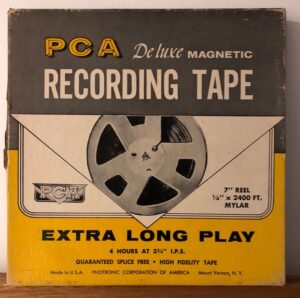
Perhaps the oddest collaboration between Mamiya and another company was the PCA Prismat V-90. PCA stands for Photronic Corporation of America of Takoma Park, MD who was a short lived distributor of radios and products for the radio and audio recording industry. A quick internet search for the company’s name returns FM tuners and magnetic tape supplies from the early 1960s.
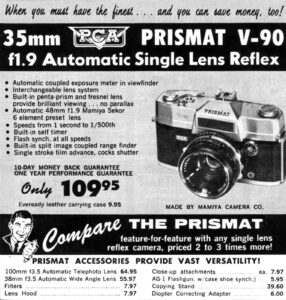
Exactly how and why Mamiya struck a deal with PCA to sell their cameras is anyone’s guess, but considering their model was first announced earlier on in 1960 suggests that a partnership with PCA happened early on in the process. It was not unusual around this time for Japanese camera makers to secure distribution partners with American companies to help market their cameras. Canon had Bell & Howell, Asahi had Honeywell, Konica had Berkey Photo, and Aires had Kalimar, so maybe PCA was just who Mamiya went with.
Whatever the case, the relationship didn’t last long as the PCA Prismat V-90 would be the only photographic product released using the PCA name. The camera went on sale in North America July 1961 and was still available new a year later as the April 1962 ad to the right from Modern Photography shows the camera for sale with a retail price of $109.95. This price when adjusted for inflation compares to about $1150 today, making it a solid mid-level option for someone wanting a nice Japanese made 35mm SLR. A version of the camera sold in Japan was called the Mamiya Prismat PH, and a third version without a meter was sold by the Sears Roebuck & Company as the Tower 37.

I had learned of the existence of the PCA Prismat V-90 while doing research for another Prismat based camera called the Argus SLR in early 2021. At that time, I was enamored at how many different models were produced using the same basic design. I had the delusion of wanting to collect them all, but after searching online, I came to my sense.
Still, my desire to own the leaf shutter V-90 came to its conclusion in late 2023 when I picked up the nice example being reviewed here. The camera was in mostly good condition with some oxidation in the metal and the focus ring on the Mamiya-Sekor lens was extremely stiff, but everything, including the shutter, worked fine.
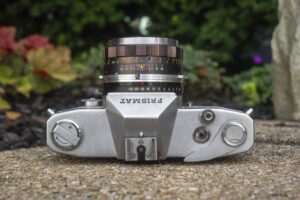
Comparing the V-90 to the Argus SLR and other Prismats I’ve handled there is definitely a family resemblance. Mamiya is no stranger to making optically excellent lenses and good cameras, so it is no surprise that the camera has a good feel to it. This example, suffering from a bit of oxidation could suggest that some moisture attached it at some point in the 60+ years it was made, but nothing too bad.
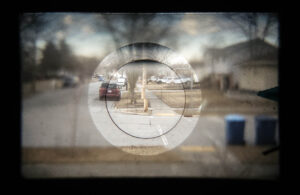
The viewfinder uses a Fresnel design which trades off the ability to see focus on the entire screen for brightness. SLR focus screens in the era this camera was made were still quite dark and often showed heavy vignetting near the corners, making seeing focus in low light difficult. Early Fresnel patterns helped correct this by spreading out the light towards the corners, but at the expense of accurate focus in anything but the middle.
On the plus side, Mamiya put a huge double split image focusing rangefinder in the center, surrounding it with a large ground glass circle. Both the circle and the focusing rangefinder can be used to focus your image, and is quite easy to do. While I would say the super bright viewfinders of SLRs from the 1980s and beyond are clearly better, what this camera can do is pretty good considering the technology of the day. The selenium cell on this example was dead, so I never got a chance to see the needle move, but I’ve used enough match needle SLRs to get how they work, and the one here is fine.
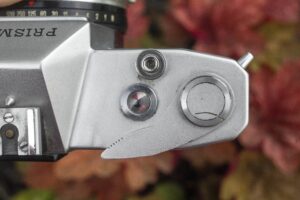
Most of the camera’s other controls are located and work how you’d expect. The film lever has a tight gearing and a sharp edge which isn’t comfortable on the pad of my thumb, plus it requires a full motion before it can swing back to its starting point, making it a bit awkward to use. Loading film into the camera is uneventful, the shutter release is comfortably located, and all exposure controls are around the lens, exactly where you’d expect to see them on a leaf shutter camera.
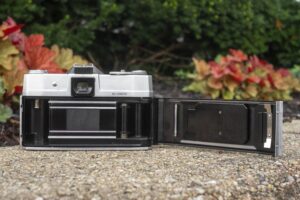
An oddity about the film compartment is that the V-90 uses half of a cloth focal plane shutter as a capping plate when the shutter is cocked. All leaf shutter SLRs require something to block light from exposing the film when the mirror is down. Because of how leaf shutters work, in order for light to pass through the lens and be reflected up into the viewfinder, the shutter must remain open while composing your image. Since the shutter is open, light would otherwise be exposing the film, so an additional plate is necessary to protect the film. Most leaf shutter SLRs do this with a “capping plate” which is connected to the mirror. As the mirror drops, the capping plate blocks the film gate. On the V-90, there is no capping plate, rather a cloth curtain like from a focal plane shutter SLR covers the film gate. It works, although is unusual.
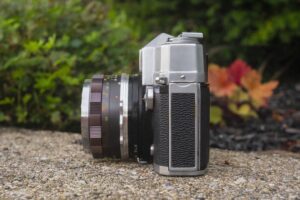
On the camera’s left side is the release latch for the film compartment. Lift up on the top edge and the door should swing open. Both sides of the camera had forward angled metal strap lugs, which helps balance the camera’s heavy weight while handling from a strap.

One of the worst aspects of the camera is the lens mount. Featuring a unique lens mount not used on any other camera, the V-90s mount isn’t entirely different from other interchangeable leaf shutter mounts like the DKL mount, other than it just doesn’t seem as well designed. Unlike every other DKL mount camera I’ve used, the process for dismounting and attaching a lens is clunky. Removing the lens requires you to press and hold a long vertical lever beneath the lens mount. This isn’t hard to do, but it feels almost like an afterthought.
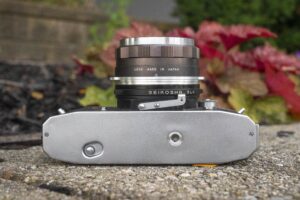
After the lens is removed, a sharp chrome aperture control ring often gets in the way of coupling the lens back to the body. Again, not difficult, but not elegant either. I am certain there are many reasons this camera and its mount wasn’t more successful, but I can assure you that even if the V-90 had sold well, there is a very good chance the mount would have been updated at some point.
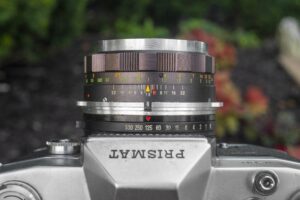
Looking down upon the top of the lens, you see the shutter speed ring for the Seikosha shutter closest to the body, then a metal ring for aperture control. This ring has a nice touch of three bumps on opposite sides allowing you to quickly locate and change f/stops on the fly.
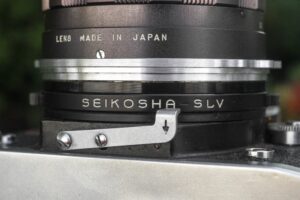
Although the V-90 lacks auto exposure, this would allow you to use it in sort of a shutter priority mode where you could choose a shutter speed that matches the lighting where you’re using the camera and just leave it alone while using the match needle in the viewfinder to change aperture to get correct exposure. Certainly, you can choose any combination of shutter speed and aperture you prefer, but this easy aperture control is just a tiny bit smoother than on other cameras. One final note about the shutter, is that there is a slider on the front face of the camera marked M, X, and V. M and X being two different flash sync speeds, but the V being the self timer. Whenever playing with an old camera like this in which it hasn’t been serviced in a very long time, I strongly caution you to not try the self-timer.
For my first roll of film in the camera, I split a roll of Kodak Vision3 50D with another camera I was using. My plan was to finish the roll and see how the camera performed and then determine if I wanted to shoot a second toll with something else. Sadly, while shooting that first test roll, the film advance locked up and I couldn’t get the camera to move anymore. Without the ability to advance the film, I can’t shoot the shutter, so I unloaded the film, developed it, and put the camera back on the shelf.
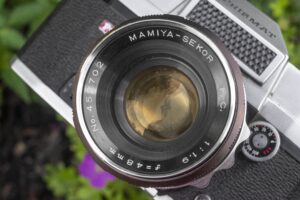
Mamiya is no stranger to making excellent lenses, and the 48mm f/1.9 Mamiya-Sekor on the PCA Prismat V-90 is no exception. I can’t prove it, but I believe this to be the same exact formula they used on other Prismats, plus the Argus SLR which I reviewed back in May 2021. Images are sharp corner to corner with excellent contrast and color rendition. Combined with the fine grain Kodak Vision3 50D, several of the images above have an almost digital look to them. While it is unlikely I’ll ever find a lens adapter for this lens to be used on a digital camera, I suspect if I did find one, digital images of many megapixels would have incredible resolution.
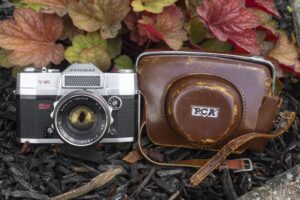
Optically, there’s absolutely nothing to complain about with the V-90. The lack of being able to see focus on the entire viewing screen, plus the less than elegant film advance lever, and poorly lens mount were all symptoms of the era in which this camera came out. More than likely, a customer purchasing this camera probably had little to no experience with other SLRs, so they probably wouldn’t have seen these as cons. They would have gotten used to it, and any nit picks they might have would definitely disappear as soon as they saw the images they got from the camera.
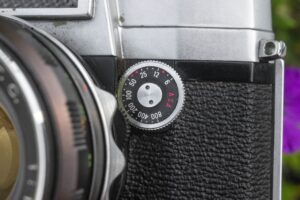
Without a doubt, the worst part of the camera is its lens mount. The most common type of leaf shutter SLR lens mount is the DKL mount and that’s a bit complicated too, the one here is just poorly designed. The small pin below the lens for releasing the bayonet is inelegant, how the aperture ring shroud sticks out with the lens removed, and a less than obvious way of reattaching the lens, Mamiya certainly could have done better. That said, having never seen another lens in this mount, I didn’t have to mess with it, other than to get images for this review, but even if I had more than one lens, I likely would never change it.
With the benefit of hindsight, I quite liked the experience of shooting the V-90 as it falls into that sweet spot where it is just modern enough that you don’t need to familiarize yourself with the manual before you can do anything, but it is old and quirky enough that you can have a little bit of fun remembering that you’re using a camera older than many people’s grandparents.
Related Posts You Might Enjoy
External Links
http://camera-wiki.org/wiki/Mamiya_Prismat_PH
http://herron.50megs.com/prismat.htm
https://kyp.hauslendale.com/classics/forum/messages/6901/3370.html?1097524139

